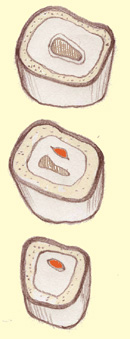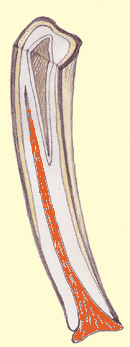How
to tell a horses age by his teeth

Cross sections
showing the effect of
wear of the teeth at
various stages.

Structure of the
lower incisor. As the
horse ages the
tooth is worn down
to reveal the patterns
shown in the 1st
illustration.
The traditional way of telling a horses age is by looking at
the horse's teeth.
There has been some dispute lately over how reliable this method
is, but in most cases an experienced vet or horseman
is generally pretty accurate in horses up to 12 years old.
The standard text on the ageing of a horse was
published in 1912 by a Mr Galvayne.
Galvayne claimed that his method was infallible
and that he could exactly age any horse or pony up to his mid
teens and then give a very good assessment after that.
The system of telling a horse's age by his teeth is based on
the fact that the teeth continue to grow throughout
the life of the horse.
As the crown of the tooth is worn away by chewing and grinding
of food, more tooth erupts from the gum to replace it.
In horses the gradual eruption of more of the teeth changes their
shape and alters the angle at which they meet.
The marks and depressions on the grinding surfaces also change
as the horse gets older.
As it isn't very easy to see the molars at the
back of the horse's mouth it is the incisors
at the front of the mouth that are used to assess a horse or pony's
age.
There are a few basic features of the horse's incisor
teeth which , when taken together, can be used to give
an estimations of the horse's age.
The features used to tell a horse's age are:
- The change from milk teeth to permanent teeth
- The presence or absence of the impression or infundibulum
on the tables of the teeth (Shown in orange on the illustrations).
- The presence of a hook or a groove on the upper corner teeth.
- The marks or dental "stars" (Shown in orange on
the top illustration) on the tables of the teeth.
- The general shape and angle of the teeth.
According to Mr Galvayne, who gave his name to the it,
Galvayne's groove and the hook on the
upper corner tooth are the keys to accurate ageing.
How to tell a horses age by his teeth is a well marked groove
which appears on the side of the upper corner tooth at about 9
years.
The hook usually appears at 7 years old then
is gradually worn away - another hook may appear at 11
years old.
Modern research has shown this to be unreliable - with hooks
present in horses from 5 to 19 years old and Galvayne's groove
appearing in horses from 5 to 29 years old.
The horse's first teeth are milk teeth - these are
replaced by permanent teeth as the horse reaches maturity. The
incisors develop as follows:
- At birth a foal has no teeth, but the 2 central
incisors cut at about 10 days old.
- The next pair of equine incisors, the lateral incisors, are
cut at 4 - 6 weeks old.
- The 3rd pair appear at 6 - 9 months.
- At 2 and a half years old the horse's 2 central milk
teeth are pushed out by the permanent central incisors.
- At 4 years old the permanent lateral incisors appear
- At the age of 5 the permanent corner incisors arrive and the
horse is said to have a "full mouth".
|